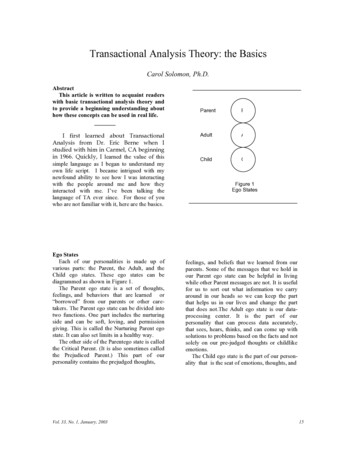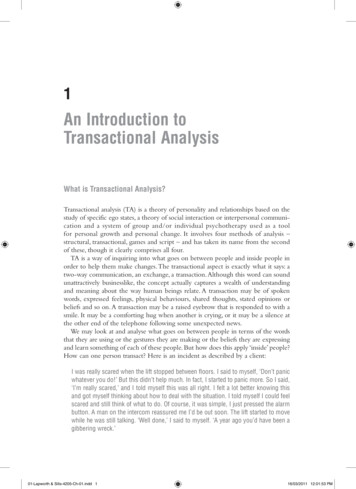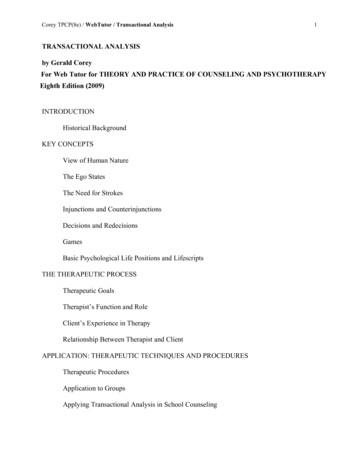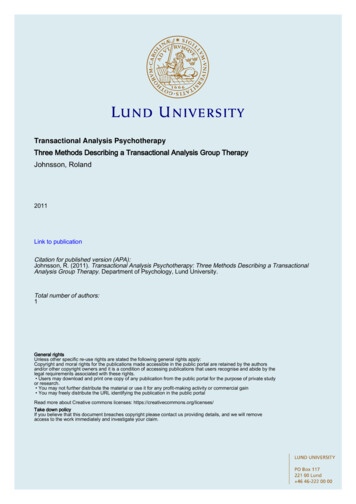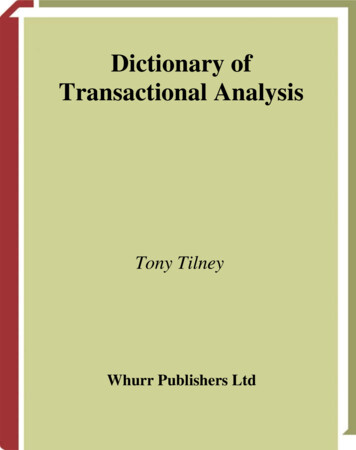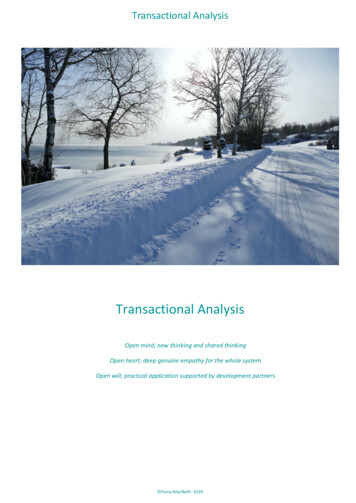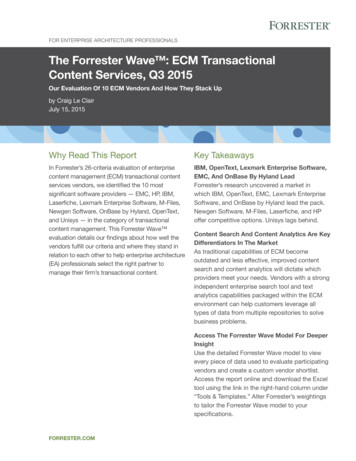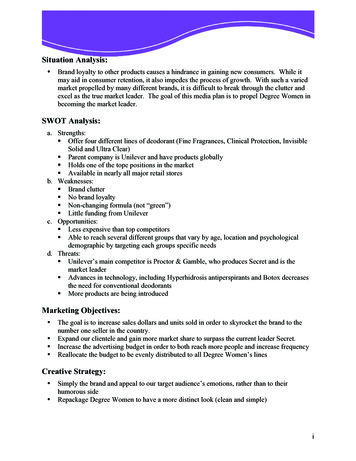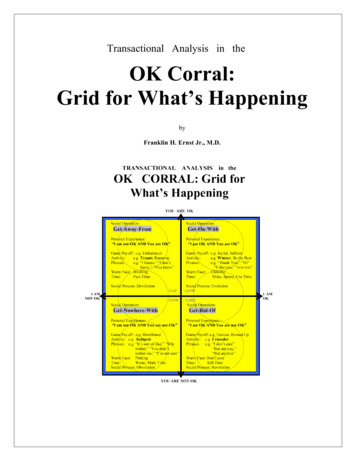
Transcription
Transactional Analysis in theOK Corral:Grid for What’s HappeningbyFranklin H. Ernst Jr., M.D.
Franklin H. Ernst Jr., M.D.Transactional Analysis in theOK Corral:Grid for What’s HappeningbyFranklin H. Ernst Jr., M.D.Copyright 2008Permission is hereby granted to any person, magazine, newspaper, other periodical, or media toreprint this monograph in any single issue of the periodical in question, so long as two conditionsare met: (1) the monograph is printed word for word, including diagrams, figures, and footnotes,and (2) the following reference is given at the bottom of the first page on which the reprintedarticle begins: “This article is taken from Transactional Analysis in the OK Corral: Grid forWhat’s Happening by Franklin H. Ernst Jr., M.D.; published by Franklin “Harry” Ernst III,Addresso’Set Publications, P.O. Box 3009, Vallejo, California 94590.”Transactional Analysis in the OK Corral: Grid for What’s Happening2 of 18
Franklin H. Ernst Jr., M.D.Transactional Analysis in theOK Corral:Grid for What’s HappeningbyFranklin H. Ernst, Jr., M.D.Man is repeatedly evaluating himself as to the value of himself to himself and also tohis companion; as to the value of his companionship for himself and for his companion. Theseare in the often silent:1. "How are you (How am I with you)?"2. "What am I going to do with you?"3. "How is this (situation with you) going to turn out?"4. "How am I going to get out of this (situation with you)?"5. "( I wonder) what (do) you think of me (now)?"6. “What are you thinking of doing to me (now)?”"What am I going do with you?" can be understood as coming from one of the fourcategories of dynamic social operations1 (Figure No.1). In fact, each of these six questions isresolved by discerning the outcome of the particular encounter with the identified otherperson. It has been found there are four major classes of outcomes which result from socialencounters.2 The four classes of outcome are called Get-On-With (GOW), Get-Rid-Of (GRO),Get-Away-From (GAF), Get-Nowhere-With (GNW). 3a. The Get-On-With (GOW) outcome of a social encounter occurs when the personalexperience of the particular person closes with an I-Am-OK and You-Are-OK.b. The Get-Rid-Of (GRO) outcome of a social encounter occurs when the personalexperience of the particular person closes with an I-Am-OK and You-Are-Not-OK.c. The Get-Away-From (GAF) outcome of a social encounter occurs when the personalexperience of the particular person closes with I-Am-Not-OK and You-Are-OK.d. The Get-Nowhere-With (GNW) outcome occurs when the personal experience of theparticular person closes with I-Am-Not-OK and You-Are-Not-OK.1Ernst, F.H. Jr., M.D.: "Social Operations," The Encounterer, 1:15, 9-20-1969, Golden Gate Foundation forGroup Treatment, Vallejo, California.2Players of the game of “Skeptic” usually jump on this statement and will invent “other classes” of outcomes.3Related papers by Franklin H. Ernst Jr., M.D.: (a) “Getting Well With Transactional Analysis: Get-On-With,Getting Well, and Get (to be) Winners”, (b) “OK Corral: Grid for What’s Happening / Eric Berne MemorialScientific Award Acceptance Speech, Boston, Mass., 1981”, (c) “Handbook of Listening / TransactionalAnalysis of the Listening Activity”, Second Edition.Transactional Analysis in the OK Corral: Grid for What’s Happening3 of 18
Franklin H. Ernst Jr., M.D.By placing “I Am OK” and “I Am not-OK” on the ends of a horizontal line AND the“You Are OK” and “You Are Not-OK” at the ends of a vertical line as shown in Figure No.1we have drawn the grid for the outcomes of personal experience. 4YOU ARE OKI AMNOT OKThe “movement” (operation) ofI Get-Away-From You (GAF)comes from the social dynamicsinherent in the personal experience ofstrokes exchanged with“I-Am-Not-OK AND You-Are-OK.”The “movement” (operation) ofI Get-On-With You (GOW)comes from the social dynamicsinherent in the personal experience ofstrokes exchanged with“I-Am-OK-AND-You-Are-OK.”The “movement” (operation) ofI Get-Nowhere-With You (GNW)comes from the social dynamicsinherent in the personal experience ofstrokes exchanged with “I-Am-NotOK AND You-Are-Not-OK.”The “movement” (operation) ofI Get-Rid-Of You (GRO)comes from the social dynamicsinherent in the personal experience ofstrokes exchanged with“I-Am-OK AND You-Are-Not-OK.”I AMOKYOU ARE NOT-OK“OK Corral: Grid for What’s Happening”Figure No.1The horizontal arrow point on the right represents “I am going ahead.” The arrowpoint on the left represents “I am not going ahead.” The vertical line: “You are OK (e.g. I lookup to you) and “You are not OK” (e.g. I look down on you).In day to day life, a person has a series of stroking encounters, one after another with avariety of persons.5,6 Some of the encounters are a simple greeting, a single transaction suchas "Hi!” “Hi!" Other encounters (with their transactions) may involve a multitude of wordsexchanged between the involved persons. Some encounters (transactions) are ritualized,others are pastimes while hanging out with each other. Some are games. Some are activities.And some encounters are the occasional quality of intimacy. Brief or extended, at theconclusion of each encounter, no matter how many transactions between the parties, theoutcome will fall into one of the four quadrants of the OK Corral.4“Transactional Analysis in the OK Corral, Grid for What’s Happening” and “personal experiences” arecombined.5Berne, Eric, M.D.: “Games People Play”, Grove Press, New York, NY, 1964, pg. 38.6Berne, Eric, M.D.: “Transactional Analysis in Psychotherapy”, Grove Press, New York, NY, 1961.Transactional Analysis in the OK Corral: Grid for What’s Happening4 of 18
Franklin H. Ernst Jr., M.D.Persons familiar with this method of classifying the outcomes of their socialencounters described by the “OK Corral: Grid for What’s Happening” report that eachindividual uses these four categories of social outcome at least once each day.7,8For example:A Get-Nowhere-With (GNW) social operation example:Bob: "Hey, Al, will you sign this paper for me? I got to hurry up and get it down to theboss."A reasoned (temporary style) GNW outcome resolution by Al could be: "Oh, hey,Bob. Let me think on it a little while first. I won't be able to do it right now." Al is saying"I-am-not-OK, yet ( I am not ready to do it ) -and-you-are-not-OK-with-me-either (onthis). I want a few minutes to look it over first. I will probably see it your way, but first letme look it over." This is a temporary Get-Nowhere-With (GNW) act of postponing. Aldid not let Bob get anywhere with him for the time being. (Conversely, it is also seen thatBob got-nowhere-with Al, either.) Al was not ready to make a decision on this, not readyto get somewhere with Bob. "I am not OK to handle it now and you are not OK with meyet either, as far as settling this one way or another now."A Get-Away-From (GAF) social (movement) operation example:Al: "Hi Bob! Good to see you!"Bob: "Yeah, good to see you too! I want to talk to you a minute, if you have it."Al: "Sorry, Bob. My supervisor has called a meeting down the hall that I have to get tonow. Maybe later in the day, though, we can do it. Okay? (while physicallyleaving)." In this encounter, Al is operationally concluding the event by gettingaway-from Bob. He is not, would not be OK if he tarried with Bob. (We also notethat from Bob's view he is, in effect, getting-rid-of Al.)A Get-Rid-Of (GRO) social operation example:Al: "Well, let's see. I think that covers all the points we had to go over for this staffconference today. Good to have met with you. See you next week. Good-bye fornow.”A Get-On-With (GOW) social operation example:Al: "Well, Bob, the papers here look like they are all in order and clear. I'll sign hereand you can sign right over here! OK?"Bob: "OK! Thanks! We can get this new distribution system working now!"7Ernst, F.H. Jr., M.D.: “Handbook of Listening, Transactional Analysis of the Listening Activity,” SecondEdition, Addresso’Set Publications, 2008.8Ernst, F.H. Jr., M.D.: “Social Operations”, The Encounterer, 1:15, Golden Gate Foundation for GroupTreatment, Vallejo, California, 9-20-1969.Transactional Analysis in the OK Corral: Grid for What’s Happening5 of 18
Franklin H. Ernst Jr., M.D.Get-Well Mechanical Style:After a person has made the decisive commitment to get-on-with getting well of aproblem (such as forgiving somebody he has been holding a grudge against), the therapist andthe patient become increasingly desirous of locating and identifying ways of conferring more"Okayness" into some of the person’s (patient's) Adult oriented encounters.An individual can initiate the use of his own Adult to bring about “in a thoughtfulmanner” some more Get-On-With operations with selected persons he encounters, in order toactivate “the position for getting well” (get-on-with) in himself more often. In grouptreatment this is called "getting well mechanical style" because of the oft announced “but Idon't feel like it,” “It feels artificial when I do it.”The person can be told that the childhood part of himself may not have changed hismind, yet, but that his Adult self is able to carry out some transactions in a manner toselectively increase the frequency of getting-on-with some situations and persons. His ownAdult can make decisions which differ from his own Child self’s view of the same situation.A person's Adult can be sorted and strengthened by a therapist (or teacher). One wayis for the therapist/teacher to highlight when the other person’s Adult is in charge; so also, theGet-On-With (GOW) operation can be identified when such is underway or just concluded bythe given person. 9, 10Millie attended group therapy to get well of a long-standing high blood pressure."And-nothing-more-was-said" was the usual payoff to her game of "Furthermore." For a longtime she rarely talked to anyone in group unless in derision or to give a soothing-toned "Whydon't you .?" (platitude) which on decoding meant "go practice drowning" or "get lost."By prescription, her Adult ego state began (at first haltingly) to give more "okays," give more"thank you’s," "good for you’s", and "you're okays" to other members of her group. One day,seemingly out of context, in a clear, focused voice, with level countenance and a warm face,she remarked: "Teenia, that lipstick you're wearing sets your complexion off the best I’ve everseen you!" Teenia, surprised out of her usually "Oh, it's nothing!" get-rid-of cross-up, camelevel herself and without affectation gave back a "Why thank you very much, Millie!" Bothlooked warmly at each other for one full second as group quietly looked on.“Prescriptions for getting well” are techniques for increasing the frequency of get-onwith encounters. Teaching, learning, and using these techniques will result in more “I am OKAND You are OK” encounters. These techniques at first are experienced as “mechanical” vsemotional style “real” activities.An example of a prescription is to recommend to a person: "Give more frequent thankyou’s to more people. You can start doing it now." The Adult of the person is explicitly toldthat these activities are techniques (giving an OK) Okaying another person and are to becarried out in order to secure (receive/get) more (reciprocated) OK's coming back to himself.This is a get-on-with program for getting well.9Berne, Eric, M.D.: “Transactional Analysis in Psychotherapy”, Social Psychiatry Seminars, TransactionalAnalysis Bulletins 1960 thru 1970.10Ernst, F.H. Jr., M.D.: “Getting Well With Transactional Analysis: Get-on-With, Getting Well, and Get (to be)Winners”, Addresso’Set Publications, 2008.Transactional Analysis in the OK Corral: Grid for What’s Happening6 of 18
Franklin H. Ernst Jr., M.D.Thoughtfully planned (thinking) Adult exercises when practiced in a “mechanical”manner (rather than with Child emotion/emotionally) will result in improving one’s socialskills.The Adult in the person may at first say they feel stiff, artificial when doing this. Oftenthe particular person carrying out the exercise “mechanical style” says “I feel like a phony” or“That’s being insincere, isn’t it?”The person committed to getting well, often reports a few days later: "I feel OK nowwhen I am giving these thank-you’s, especially when I see the other person warming up backto me. It works!"Other “prescriptions for getting well” are:(1) "Get a level (head)," 11(2) "Gently rub your back teeth over each other,"(3) "Give a Named Hello to 15 people a day,"(4) "Make a (name) Seating Diagram of meetings and classrooms.(5) "When saying hello to people call him/her by name (e.g. Hi John). If you don’tremember their name, ask him/her for it. Get a hello AND your name said back toyou."(6) "Talk in duet with a friend for 20 to 30 seconds, every once in awhile."For those to whom "get-well-mechanical style" is strange, there is this to say: “GetWell Mechanical Style” is an operational form of the Adult ego state in the person leading hisown inside "troubled" Child “to come on and get a GET-WELL” (of your symptom). “Let’sget well first and (we can) find out why later!” The initial mechanical stiffness is similar tolearning to play a musical instrument or speak a new language, or when first riding a bicycle.With some practice it gets easier and feels more sincere. On occasion, “get well mechanicalstyle” is referred to as “Get Some PRACTICE AT BEING WELL!”11Ernst, F.H. Jr., M.D.: “Handbook of Listening, Transactional Analysis of the Listening Activity”, SecondEdition, Addresso’Set Publications, Vallejo, California, 2008.Transactional Analysis in the OK Corral: Grid for What’s Happening7 of 18
Franklin H. Ernst Jr., M.D.Taking Advantage of the Windows of Opportunity for a get-on-with:There are various kinds of opportunities people have for a get-on-with each other (Iam OK AND You are OK kind of events). There are Parent types of encounters. Encounterscan be handled by personal Adult monitored mechanical style procedures or encountersre
Transactional Analysis in the OK Corral: Grid for What’s Happening 6 of 18 Get-Well Mechanical Style: After a person has made the decisive commitment to get-on-with getting well of a problem (such as forgiving somebody he has been holding a grudge against), the therapist and the patient become increasingly desirous of locating and identifying ways of conferring more "Okayness" into some of .
